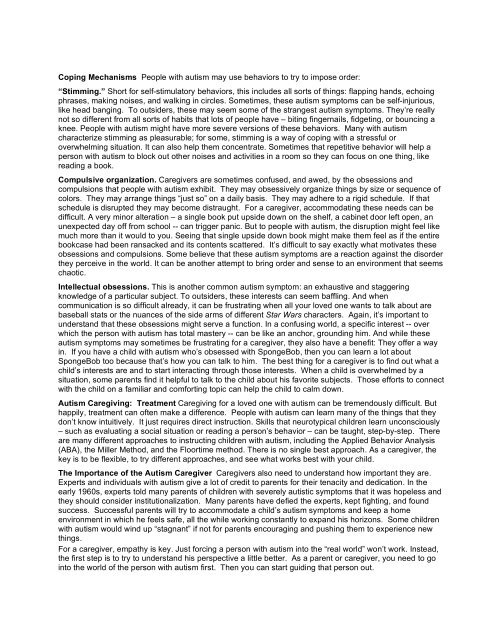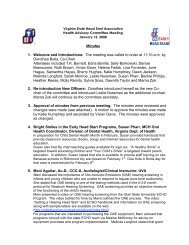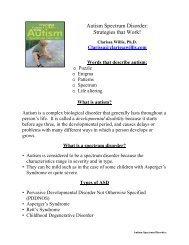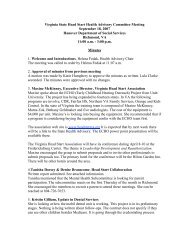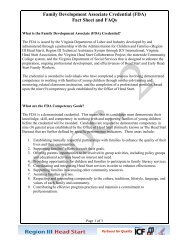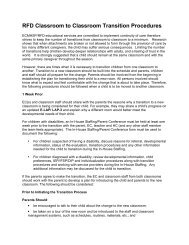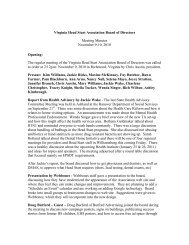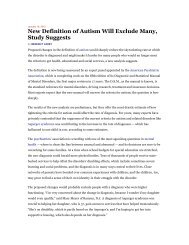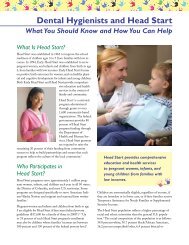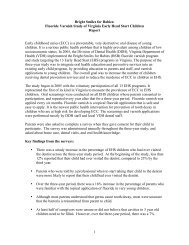What It's Like to Have Autism - Virginia Head Start Association
What It's Like to Have Autism - Virginia Head Start Association
What It's Like to Have Autism - Virginia Head Start Association
You also want an ePaper? Increase the reach of your titles
YUMPU automatically turns print PDFs into web optimized ePapers that Google loves.
Coping Mechanisms People with autism may use behaviors <strong>to</strong> try <strong>to</strong> impose order:<br />
“Stimming.” Short for self-stimula<strong>to</strong>ry behaviors, this includes all sorts of things: flapping hands, echoing<br />
phrases, making noises, and walking in circles. Sometimes, these autism symp<strong>to</strong>ms can be self-injurious,<br />
like head banging. To outsiders, these may seem some of the strangest autism symp<strong>to</strong>ms. They’re really<br />
not so different from all sorts of habits that lots of people have – biting fingernails, fidgeting, or bouncing a<br />
knee. People with autism might have more severe versions of these behaviors. Many with autism<br />
characterize stimming as pleasurable; for some, stimming is a way of coping with a stressful or<br />
overwhelming situation. It can also help them concentrate. Sometimes that repetitive behavior will help a<br />
person with autism <strong>to</strong> block out other noises and activities in a room so they can focus on one thing, like<br />
reading a book.<br />
Compulsive organization. Caregivers are sometimes confused, and awed, by the obsessions and<br />
compulsions that people with autism exhibit. They may obsessively organize things by size or sequence of<br />
colors. They may arrange things “just so” on a daily basis. They may adhere <strong>to</strong> a rigid schedule. If that<br />
schedule is disrupted they may become distraught. For a caregiver, accommodating these needs can be<br />
difficult. A very minor alteration – a single book put upside down on the shelf, a cabinet door left open, an<br />
unexpected day off from school -- can trigger panic. But <strong>to</strong> people with autism, the disruption might feel like<br />
much more than it would <strong>to</strong> you. Seeing that single upside down book might make them feel as if the entire<br />
bookcase had been ransacked and its contents scattered. It’s difficult <strong>to</strong> say exactly what motivates these<br />
obsessions and compulsions. Some believe that these autism symp<strong>to</strong>ms are a reaction against the disorder<br />
they perceive in the world. It can be another attempt <strong>to</strong> bring order and sense <strong>to</strong> an environment that seems<br />
chaotic.<br />
Intellectual obsessions. This is another common autism symp<strong>to</strong>m: an exhaustive and staggering<br />
knowledge of a particular subject. To outsiders, these interests can seem baffling. And when<br />
communication is so difficult already, it can be frustrating when all your loved one wants <strong>to</strong> talk about are<br />
baseball stats or the nuances of the side arms of different Star Wars characters. Again, it’s important <strong>to</strong><br />
understand that these obsessions might serve a function. In a confusing world, a specific interest -- over<br />
which the person with autism has <strong>to</strong>tal mastery -- can be like an anchor, grounding him. And while these<br />
autism symp<strong>to</strong>ms may sometimes be frustrating for a caregiver, they also have a benefit: They offer a way<br />
in. If you have a child with autism who’s obsessed with SpongeBob, then you can learn a lot about<br />
SpongeBob <strong>to</strong>o because that’s how you can talk <strong>to</strong> him. The best thing for a caregiver is <strong>to</strong> find out what a<br />
child’s interests are and <strong>to</strong> start interacting through those interests. When a child is overwhelmed by a<br />
situation, some parents find it helpful <strong>to</strong> talk <strong>to</strong> the child about his favorite subjects. Those efforts <strong>to</strong> connect<br />
with the child on a familiar and comforting <strong>to</strong>pic can help the child <strong>to</strong> calm down.<br />
<strong>Autism</strong> Caregiving: Treatment Caregiving for a loved one with autism can be tremendously difficult. But<br />
happily, treatment can often make a difference. People with autism can learn many of the things that they<br />
don’t know intuitively. It just requires direct instruction. Skills that neurotypical children learn unconsciously<br />
– such as evaluating a social situation or reading a person’s behavior – can be taught, step-by-step. There<br />
are many different approaches <strong>to</strong> instructing children with autism, including the Applied Behavior Analysis<br />
(ABA), the Miller Method, and the Floortime method. There is no single best approach. As a caregiver, the<br />
key is <strong>to</strong> be flexible, <strong>to</strong> try different approaches, and see what works best with your child.<br />
The Importance of the <strong>Autism</strong> Caregiver Caregivers also need <strong>to</strong> understand how important they are.<br />
Experts and individuals with autism give a lot of credit <strong>to</strong> parents for their tenacity and dedication. In the<br />
early 1960s, experts <strong>to</strong>ld many parents of children with severely autistic symp<strong>to</strong>ms that it was hopeless and<br />
they should consider institutionalization. Many parents have defied the experts, kept fighting, and found<br />
success. Successful parents will try <strong>to</strong> accommodate a child’s autism symp<strong>to</strong>ms and keep a home<br />
environment in which he feels safe, all the while working constantly <strong>to</strong> expand his horizons. Some children<br />
with autism would wind up “stagnant” if not for parents encouraging and pushing them <strong>to</strong> experience new<br />
things.<br />
For a caregiver, empathy is key. Just forcing a person with autism in<strong>to</strong> the “real world” won’t work. Instead,<br />
the first step is <strong>to</strong> try <strong>to</strong> understand his perspective a little better. As a parent or caregiver, you need <strong>to</strong> go<br />
in<strong>to</strong> the world of the person with autism first. Then you can start guiding that person out.


